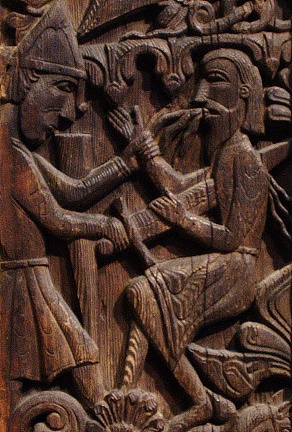|
Refil (other) ''
{{disambiguation ...
Refil may refer to: * Refil Björnsson, a son of the Swedish king Björn Ironside and brother of king Erik Björnsson in '' Hervarar saga'' and in ''Nafnaþulur'' * Refil (sword), the sword of Regin in ''Skáldskaparmál ''Skáldskaparmál'' (Old Norse: 'The Language of Poetry'; c. 50,000 words; ; ) is the second part of the ''Prose Edda''. The section consists of a dialogue between Ægir, the divine personification of the sea, and Bragi, the god of poetry, in ... [...More Info...] [...Related Items...] OR: [Wikipedia] [Google] [Baidu] |
Refil Björnsson
Refil Björnsson (c. 850?) was a Swedish prince, grandson of Ragnar Lodbrok, who allegedly flourished in the early Viking Age and had a certain dynastic importance. His historical existence is uncertain. Virtually our only source for his person is the ''Hervarar saga ok Heiðreks'' (13th century) that concludes with a brief chronicle of Swedish kings up to 1118. This text says that the renowned Viking ruler Ragnar Lodbrok, after his demise, was succeeded by his various sons who ruled over Sweden, Denmark, the eastern lands (Austrríki) and England. Björn Ironside was assigned the Swedish realm. This information is historically problematic since Björn is otherwise known to have performed Viking raids in West Francia in the 850s and allegedly died in Frisia in the early 860s. According to the ''Hervarar saga'' Björn had two sons called Erik and Refil. Erik inherited the Swedish kingship, though he only ruled for a short time. The younger son Refil was a "warrior king and sea king" ... [...More Info...] [...Related Items...] OR: [Wikipedia] [Google] [Baidu] |
Björn Ironside
according to Norse legends, was a Norse Viking chief and Swedish king. According to the 12th- and 13th-century Scandinavian histories, he was the son of notorious Viking king Ragnar Lodbrok and lived in the 9th century, between 855 and 858. Björn Ironside is said to have been the first ruler of the Swedish Munsö dynasty. In the early 18th century, a barrow on the island of Munsö was claimed by antiquarians to be ''Björn Järnsidas hög'' or Björn Ironside's barrow.Lagerquist 1997:24 Medieval sources refer to Björn Ironside's sons and grandsons, including Erik Björnsson and Björn at Haugi. Icelandic sagas claim that Björn was the ancestor of the house of Munsö, the line of kings that ruled in Sweden until c. 1060. Björn in Frankish sources "Berno" was a powerful Viking chieftain and naval commander. He appears in contemporary sources such as ''Annales Bertiniani'' and the '' Chronicon Fontanellense''. He is first mentioned in the summer of 855. The oldest text that d ... [...More Info...] [...Related Items...] OR: [Wikipedia] [Google] [Baidu] |
Erik Björnsson
Erik Björnsson was supposedly one of the sons of Björn Ironside and a legendary king of Sweden of the House of Munsö, who would have lived in the late 9th century. One of the few surviving Scandinavian sources that deal with Swedish kings from this time is '' Hervarar saga''. The saga is from the 12th or 13th century and is thus not considered a reliable historical source for the 9th century. It says: Notes and references See also *Early Swedish History Early may refer to: History * The beginning or oldest part of a defined historical period, as opposed to middle or late periods, e.g.: ** Early Christianity ** Early modern Europe Places in the United States * Early, Iowa * Early, Texas * E ... {{DEFAULTSORT:Erik Bjornsson Semi-legendary kings of Sweden 9th-century rulers in Europe House of Munsö 9th-century Swedish people ... [...More Info...] [...Related Items...] OR: [Wikipedia] [Google] [Baidu] |
Nafnaþulur
''Nafnaþulur'' (Old Norse: ) is a subsection of the ''Prose Edda'', the last part of the ''Skáldskaparmál ''Skáldskaparmál'' (Old Norse: 'The Language of Poetry'; c. 50,000 words; ; ) is the second part of the ''Prose Edda''. The section consists of a dialogue between Ægir, the divine personification of the sea, and Bragi, the god of poetry, in ...''. It is a listing in verse of names that may be used in poetry for various items, such as gods, giants, people, animals, and weapons. The verses are not in all manuscripts of the ''Edda'' and appear independently, and are probably a later addition to Snorri's original composition; they may have been one of its sources. Jan de Vries, ''Altnordische Literaturgeschichte'' volume 2, Berlin: de Gruyter, 1967pp. 225-26 They are often omitted from editions and translations of the ''Edda''. References External links (verses 1-20; continues Skaldic poetry Sources of Norse mythology {{norse-myth-stub ... [...More Info...] [...Related Items...] OR: [Wikipedia] [Google] [Baidu] |
Regin
In Norse mythology, Reginn (Old Norse: ᚱᛁᚼᛁᚾ/ᚱᛁᚽᛁᚿ ; often anglicized as Regin or Regan) is a son of Hreiðmarr and the foster father of Sigurd. His brothers are Fafnir and Ótr. Regin in the sagas When Loki mistakenly kills Ótr, Hreiðmarr demands to be repaid with the amount of gold it takes to fill Ótr's skin and cover the outside. Loki takes this gold from the dwarf Andvari, who curses it and especially the ring Andvaranaut. Fafnir kills his father for this gold, but eventually becomes a greedy dragon. Reginn gets none of the gold, but he becomes smith to the king and foster father to Sigurd, teaching him many languages as well as sports, chess, and runes. Reginn had all wisdom and deftness of hand. Of his two brothers, he has the ability to work iron as well as silver and gold and he makes many beautiful and useful things. While Sigurd is living with Reginn, Reginn challenges Sigurd's respect in the kingdom. He tells Sigurd to ask for a horse. Si ... [...More Info...] [...Related Items...] OR: [Wikipedia] [Google] [Baidu] |
.jpg)
